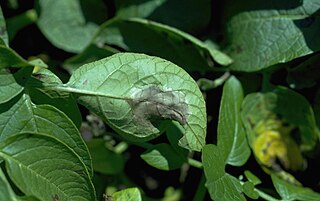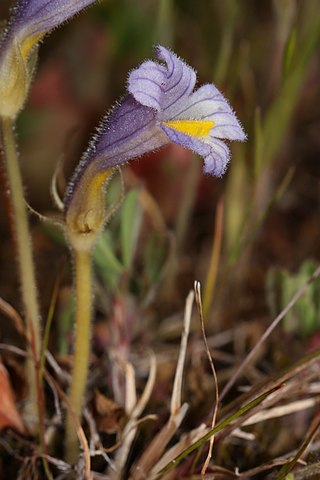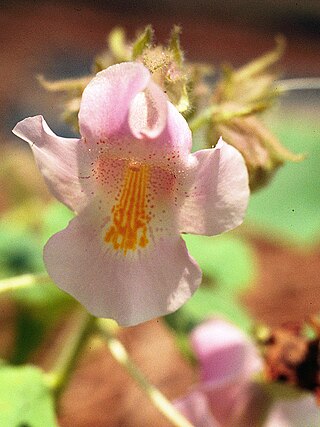
Phytophthora infestans is an oomycete or water mold, a fungus-like microorganism that causes the serious potato and tomato disease known as late blight or potato blight. Early blight, caused by Alternaria solani, is also often called "potato blight". Late blight was a major culprit in the 1840s European, the 1845–1852 Irish, and the 1846 Highland potato famines. The organism can also infect some other members of the Solanaceae. The pathogen is favored by moist, cool environments: sporulation is optimal at 12–18 °C (54–64 °F) in water-saturated or nearly saturated environments, and zoospore production is favored at temperatures below 15 °C (59 °F). Lesion growth rates are typically optimal at a slightly warmer temperature range of 20 to 24 °C.

Orobanche, commonly known as broomrape, is a genus of almost 200 species of small parasitic herbaceous plants, mostly native to the temperate Northern Hemisphere. It is the type genus of the broomrape family Orobanchaceae.

Orobanchaceae, the broomrapes, is a family of mostly parasitic plants of the order Lamiales, with about 90 genera and more than 2000 species. Many of these genera were formerly included in the family Scrophulariaceae sensu lato. With its new circumscription, Orobanchaceae forms a distinct, monophyletic family. From a phylogenetic perspective, it is defined as the largest crown clade containing Orobanche major and relatives, but neither Paulownia tomentosa nor Phryma leptostachya nor Mazus japonicus.

A parasitic plant is a plant that derives some or all of its nutritional requirements from another living plant. They make up about 1% of angiosperms and are found in almost every biome. All parasitic plants develop a specialized organ called the haustorium, which penetrates the host plant, connecting them to the host vasculature – either the xylem, phloem, or both. For example, plants like Striga or Rhinanthus connect only to the xylem, via xylem bridges (xylem-feeding). Alternately, plants like Cuscuta and some members of Orobanche connect to both the xylem and phloem of the host. This provides them with the ability to extract resources from the host. These resources can include water, nitrogen, carbon and/or sugars. Parasitic plants are classified depending on the location where the parasitic plant latches onto the host, the amount of nutrients it requires, and their photosynthetic capability. Some parasitic plants can locate their host plants by detecting volatile chemicals in the air or soil given off by host shoots or roots, respectively. About 4,500 species of parasitic plants in approximately 20 families of flowering plants are known.

Orobanche aegyptiaca, the Egyptian broomrape, is a plant which is an obligate holoparasite from the family Orobanchaceae with a complex lifecycle. This parasite is most common in the Middle East and has a wide host range including many economically important crops.

Orobanche uniflora, commonly known as one-flowered broomrape, one-flowered cancer root, ghost pipe or naked broomrape, is an annual parasitic herbaceous plant. It is native to much of North America, where it is a parasitic plant, tapping nutrients from many other species of plants, including those in the families Asteraceae and Saxifragaceae and in the genus Sedum. The name "orobanche" can be translated to "vetch-strangler" and "uniflora" can be translated to "single-flower".

Amaranthus tuberculatus, commonly known as roughfruit amaranth, rough-fruited water-hemp, tall waterhemp, or common waterhemp, is a species of flowering plant. It is a summer annual broadleaf with a germination period that lasts several months. Tall waterhemp has been reported as a weed in 40 of 50 U.S. states.

Anoda cristata is a species of flowering plant in the mallow family known by many common names, including spurred anoda, crested anoda, and violettas. It is native to North and South America. It is known throughout the rest of the Americas as well as Australia as an introduced species and often a noxious weed. It has been found as a weed in Belgium. Naturally, it is often found near streams, in moist meadows, and in disturbed areas.

Orobanche minor, the hellroot, common broomrape, lesser broomrape, small broomrape or clover broomrape, is a holoparasitic flowering plant belonging to the family Orobanchaceae. It is one of about 150 non-photosynthetic plants in the genus Orobanche that parasitize autotrophic plants.

Orobanche californica, known by the common name California broomrape, is a species of broomrape. It is a parasitic plant growing attached to the roots of other plants, usually members of the Asteraceae.

Orobanche cooperi is a species of broomrape known by the common name Cooper's broomrapedesert broomrape, spike broomrape, and burroweed strangler. It is native to the desert regions of the southwestern United States and northern Mexico, where it is a parasite growing attached to the roots of other plants, usually members of the Asteraceae, such as Artemisia, Hymenoclea, Ambrosia and Encelia. Although not usually weedy, it has been found infesting agricultural cropland, including tomato fields in inland California. This plant arises from a thick root and a scaly, twisted stem base, and produces a thick, clumpy stem up to 40 centimeters tall. As a parasite taking its nutrients from a host plant, it lacks leaves and chlorophyll. It is dark purple in color and coated with glandular hairs. The inflorescence is an elongated array of several flowers. Each flower is tubular, purple and hairy, and up to about 3 centimeters long.

Orobanche corymbosa is a species of broomrape known by the common name flat-top broomrape. It is native to western North America where it is a parasite growing attached to the roots of other plants, usually sagebrush. It produces a cluster of thick, glandular stems with enlarged bases and stout roots, the hairy stems pale whitish or yellowish, often purple-tinged, and up to 17 centimetres (6.7 in) tall. As a parasite taking its nutrients from a host plant, it lacks leaves and chlorophyll. The inflorescence is a wide array of a few tubular flowers. Each is 2 centimetres (0.79 in) or 3 centimetres (1.2 in) long, coated in glandular hairs, and dark-veined pink or purple in color.

Orobanche parishii is a species of broomrape known by the common names Parish's broomrape and short-lobed broomrape. It is native to the coast and mountains of California and Baja California, where it is a parasite growing attached to the roots of other plants, usually shrubs of the Asteraceae, such as Menzies' goldenbush. This plant produces usually one thick, hairy, glandular, pale yellowish stem up to about 26 centimetres (10 in) tall. As a parasite taking its nutrients from a host plant, it lacks leaves and chlorophyll. The inflorescence is a dense cluster of flowers accompanied by dark-veined oval bracts. Each flower has a calyx of triangular sepals and a tubular corolla roughly 2 centimetres (0.8 in) long, pale brownish or pinkish in color with red veining.
Orobanche pinorum is a species of broomrape known by the common name conifer broomrape. It is native to the forests of western North America, where it is a parasite growing attached to the roots of other plants, usually Holodiscus species. This plant has an erect stem with a wide, thickened base and slender top growing 10–30 centimetres (3.9–11.8 in) tall. As a parasite taking its nutrients from a host plant, it lacks leaves and chlorophyll and is brownish or yellowish in color. The inflorescence is a dense, spreading array of purple-tinged yellowish flowers 1–2 centimetres (0.39–0.79 in) long.

Orobanche vallicola is a species of broomrape known by the common name hillside broomrape.

Parthenium hysterophorus is a species of flowering plant in the family Asteraceae. It is native to the American tropics. Common names include Santa-Maria, Santa Maria feverfew, whitetop weed, and famine weed. In India, it is locally known as carrot grass, congress grass or gajar ghas or dhanura. It is a common invasive species in India, Australia, and parts of Africa.

Proboscidea louisianica is a species of flowering plant in the family Martyniaceae. Its true native range is unclear, but probably includes parts of the southwestern United States and Mexico in North America. It occurs in other areas, including other regions in North America, Europe, Australia, and South Africa, as an introduced species. It is the most widely distributed species in its family. Common names it shares with other Proboscidea species include devil's claw and unicorn-plant. Names more specific to the species include common devil's claw, ram's horn, aphid trap, Louisiana unicorn-plant, purple-flowered devil's-claw, goat's head, and elephant tusks.

Orobanche hederae, the ivy broomrape, is, like other members of the genus Orobanche, a parasitic plant without chlorophyll, and thus totally dependent on its host, which is ivy. It grows to 60 cm (2 ft), with stems in shades of brown and purple, sometimes yellow. The flowers are 10–22 mm (0.4–0.9 in) long, cream in colour with reddish-purple veins.

Jonathan Gressel is an Israeli agricultural scientist and Professor Emeritus at the Weizmann Institute of Science in Rehovot, Israel. Gressel is a "strong proponent of using modern genetic techniques to improve agriculture" especially in third world and developing countries such as Africa. In 2010, Gressel received Israel's highest civilian award, the Israel Prize, for his work in agriculture.

Urochloa ramosa, the browntop millet or Dixie signalgrass, is an annual, millet grass belonging to the grass family (Poaceae). The native range of Urochloa ramosa is from Africa to tropical and subtropical Asia.



















